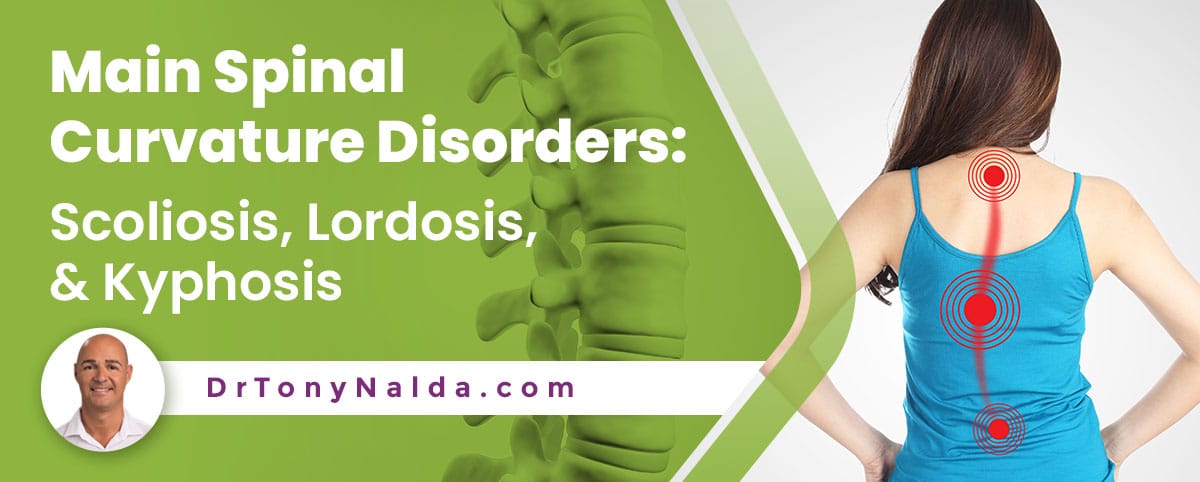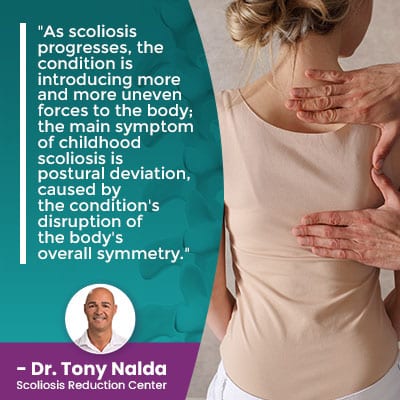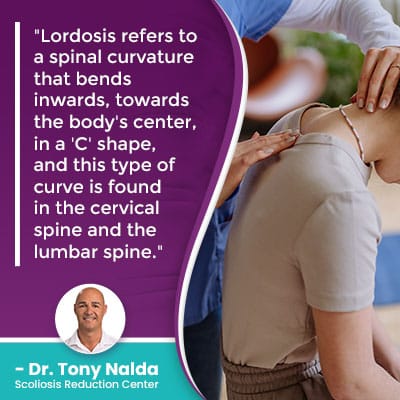Main Spinal Curvature Disorders: Scoliosis, Lordosis, & Kyphosis

In order for a healthy spine to function optimally as designed, it needs to maintain its natural curvatures. There are three main spinal sections, each with its own curvature type, and if one of those curves falls beyond a normal size range, problems can occur. Continue reading to understand the difference between scoliosis, lordosis, and kyphosis.
The spine's natural curvatures make it more flexible, stronger, and better able to distribute mechanical stress incurred during activity. There are a number of spinal conditions that involve a loss of its healthy curves; scoliosis, lordosis, and kyphosis are among the most common.
Let's explore scoliosis, lordosis, and kyphosis to see the similarities and differences between these prevalent spine curvature disorders.
Table of Contents
What is Scoliosis?
People diagnosed with scoliosis have developed an unnatural sideways curvature of the spine, and while there are a number of spinal conditions that involve an unnatural spinal curvature, what sets scoliosis apart is its rotational component.
A scoliotic curve doesn't just bend unnaturally to the side, but also rotates, meaning it also twists from back to front, front to back, making it a complex 3-dimensional condition.
In addition, the scoliosis curve has to be of a certain size: a minimum Cobb angle measurement of at least 10 degrees.
A patient's Cobb angle is determined during X-ray by drawing lines from the curve's most-tilted vertebrae, at its apex, and the resulting angle is expressed in degrees; this tells me how far out of alignment a scoliotic spine is.
In addition, a patient's Cobb angle also classifies conditions in terms of severity:
- Mild scoliosis: Cobb angle measurement of between 10 and 25 degrees
- Moderate scoliosis: Cobb angle measurement of between 25 and 40 degrees
- Severe scoliosis: Cobb angle measurement of 40+ degrees
- Very-severe scoliosis: Cobb angle measurement of 80+ degrees
As you can see, scoliosis ranges widely in severity, which is why its complex nature necessitates the customization of effective treatment plans.
Scoliosis is Progressive
An important characteristic of scoliosis is its progressive nature; scoliosis is virtually guaranteed to get worse over time; only proactive treatment can work towards counteracting the condition's progressive nature.
So a mild spinal curvature can easily progress to become a moderate, or severe spinal curvature, if not treated proactively.
 As scoliosis progresses, the condition is introducing more and more uneven forces to the body; the main symptom of childhood scoliosis is postural deviation, caused by the condition's disruption of the body's overall symmetry.
As scoliosis progresses, the condition is introducing more and more uneven forces to the body; the main symptom of childhood scoliosis is postural deviation, caused by the condition's disruption of the body's overall symmetry.
The main symptom of scoliosis in adults is pain because scoliosis becomes a compressive condition when skeletal maturity has been reached, so there is a focus on how to relieve pain when treating adults with scoliosis.
There are also different types of scoliosis: idiopathic scoliosis, neuromuscular scoliosis, degenerative scoliosis, and congenital scoliosis.
The most-prevalent type of scoliosis is adolescent idiopathic scoliosis, diagnosed between the ages of 10 and 18, and while idiopathic means we don't fully understand its causation, we do know what triggers its progression: growth and development.
So young patients who are still growing are at the highest risk for rapid-phase progression due to the constant trigger of growth.
Scoliosis is simplest to treat early in the condition's progressive line, which is why being proactive with treatment is so important.
Although there are never treatment guarantees, early detection and intervention does increase the likelihood of treatment success, and this also means helping patients avoid needing invasive treatment, like spinal fusion surgical treatment, in the future.
While traditional scoliosis treatment tends to funnel patients into spinal fusion, a modern conservative treatment approach values being proactive in an effort to prevent progression, increasing condition severity, and escalating symptoms.
Now, let's move on to another prevalent spinal condition: lordosis.
What is Lordosis?
There are three main spinal sections: cervical spine (neck), thoracic spine (middle/upper back), and the lumbar spine (lower back).
As mentioned, each of these spinal sections has its own characteristic curvature type.
 Lordosis refers to a spinal curvature that bends inwards, towards the body's center, in a 'C' shape, and this type of curve is found in the cervical spine and the lumbar spine.
Lordosis refers to a spinal curvature that bends inwards, towards the body's center, in a 'C' shape, and this type of curve is found in the cervical spine and the lumbar spine.
Now, there is a natural range of lordosis that can vary from person to person, but if a person's lordotic curve becomes excessive, the biomechanics of the spine are disrupted, causing problems to occur.
A natural range of cervical lordosis is considered to be between 20 and 40 degrees, while a healthy range of lumbar lordosis falls between 40 and 60 degrees.
Once a person's lordosis is considered excessive, this is also known as hyperlordosis.
The main symptom of excessive lordosis is a swayback appearance, as the buttocks and abdomen protrude unnaturally.
What is Kyphosis?
Kyphosis refers to thoracic spine's outward curvature, bending away from the body's center in a reverse 'C' shape.
A healthy range of thoracic kyphosis would be between 20 and 40 degrees, and if a person's thoracic kyphosis becomes excessive, as hyperkyphosis, the condition's main symptom is postural deviation that involves an abnormally rounded upper back and shoulders, commonly referred to as roundback.
The three most common types of kyphosis, aka hyperkyphosis, are postural kyphosis, Scheuermann's kyphosis, and congenital kyphosis.
Postural Kyphosis
Postural kyphosis is not a structural condition and is commonly caused by poor posture so is the simplest to treat with a combination of lifestyle guidance and physical therapy.
In spinal conditions that are postural, the unnatural spinal curve can be reduced and/or eliminated with a change in body position or an active effort to straighten the spine.
Scheuermann's Kyphosis
Scheuermann's kyphosis is a structural condition that involves a structural abnormality within the spine itself, so this type is more complex to treat as it has to, first and foremost, be impacted on a structural level.
Oftentimes, the spine's abnormal curve is caused by vertebrae (bones of the spine) being more triangular, than their normal rectangular shape, and this causes the spine to wedge forward, become misaligned, and develop an unnatural spine curvature.
Scheuermann's curvatures tend to be more rigid, progressive, and generally, is a more severe spinal curvature disorder that's diagnosed in adolescents, more commonly in males.
Congenital Kyphosis
Congenital kyphosis is caused by abnormal vertebrae development that occurs in utero as the spine is forming.
Congenital kyphosis can involve what's known as failure of segmentation, when vertebrae don't form into distinct and separate vertebral bodies and intervertebral discs.
Babies are born with congenital kyphosis so treatment has to be adjusted to address the unique challenges associated with treating patients of such a young age; in some cases, congenital kyphosis exercises can help, but in others, spine surgery is necessary.
Conclusion
There are a number of spinal conditions a person can develop, and prevalent ones involving a loss of its healthy curves include scoliosis, lordosis, and kyphosis.
Spinal conditions that involve the development of an unnatural spinal curve disrupt the healthy spine biomechanics and function; they are diagnosed through a combination of physical examinations that often involve the patient bending forward (Adam's forward bend test) so the spine and related postural asymmetries are at their most noticeable, and magnetic resonance imaging to see what's really happening in and around the spine.
Scoliosis is the leading spinal condition amongst school-aged children and can affect all ages from babies to the elderly and every age in between; it involves the development of an unnatural sideways curve of the spine that also rotates.
The most prevalent type of scoliosis is idiopathic, meaning not clearly associated with a single-known cause, and the most prevalent form of scoliosis overall is adolescent idiopathic scoliosis diagnosed between the ages of 10 and 18.
Lordosis curves significantly bend forward, and if a person's cervical or lumbar lordosis become over-pronounced, a swayback appearance develops as the buttocks and abdomen protrude excessively.
If a person's thoracic kyphotic curve bends excessively backwards, this can cause the development of an arch in the upper back, impacting the ability to stand upright, and giving the upper back and shoulders a roundback appearance.
Spinal conditions like scoliosis, lordosis, and kyphosis can involve gentle curves, moderate curves, or severe curves, and while postural conditions, like postural kyphosis, can be caused by just poor posture, structural conditions are caused by an abnormality within the spine itself.
In addition to postural changes, abnormal spinal curvatures can cause a wide range of symptoms shaped by how the spinal nerves are affected.
While there are never treatment guarantees, spine curvature disorders treated proactively are more likely to have a positive outcome.
Here at the Scoliosis Reduction Center, I've treated a wide range of spinal conditions: scoliosis, lordosis, and kyphosis included.
Dr. Tony Nalda
DOCTOR OF CHIROPRACTIC
After receiving an undergraduate degree in psychology and his Doctorate of Chiropractic from Life University, Dr. Nalda settled in Celebration, Florida and proceeded to build one of Central Florida’s most successful chiropractic clinics.
His experience with patients suffering from scoliosis, and the confusion and frustration they faced, led him to seek a specialty in scoliosis care. In 2006 he completed his Intensive Care Certification from CLEAR Institute, a leading scoliosis educational and certification center.
About Dr. Tony Nalda
 Ready to explore scoliosis treatment? Contact Us Now
Ready to explore scoliosis treatment? Contact Us Now





